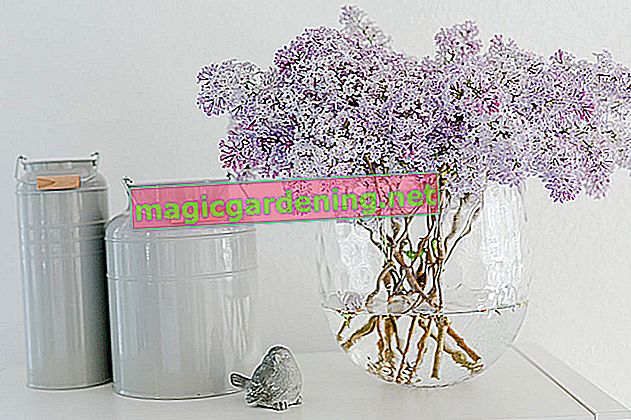
The best time to cut the lilac
As beautiful as lilacs look in the vase, they also wilt quickly. So that you can enjoy such a bouquet for longer, it is best to cut the flower stalks in the early morning. Select panicles whose flowers have not yet opened. In addition, the stems should have no leaves or as few leaves as possible. Do not simply bend the shoots from the bush, but cut them cleanly at their roots with sharp scissors or a knife.
also read
- How does lilac stay long in the vase?
- Planting lilacs in autumn - instructions and tips
- Can you transplant lilacs? How the project works best
Prepare lilacs properly for the vase
Then you should treat the stems as follows for a longer shelf life of the flowers:
- Cut the stems several centimeters at the lower end, that is, split the end of the shoot.
- This measure increases the area and thus the possibility of water absorption.
- Now dip the ends of the handles briefly in hot water.
- This, too, increases the ability of the stems to absorb water.
- Always place the flower stalks in warm (and not in cold!) Water.
Don't make the mistake of simply patting the stem ends flat. In doing so, you destroy valuable surface and plant cells for water absorption, with the result that you shorten rather than lengthen the flowering period.
Take good care of lilacs as cut flowers
If possible, cut lilacs should not be in a sunny and warm place, for example on a window sill. Here the bouquet dries up faster. Instead, place the vase in a bright, but not directly sunny place. Change the water daily and do not add any home remedies such as sugar. This often only leads to the fact that mushrooms settle and the lilacs quickly wither. On that occasion, you should cut the stems again for the same reason.
The best possible combinations for a lilac bouquet
A bouquet of lilacs looks impressive on its own, regardless of whether you put it together in one or more colors. During a walk, however, you will find numerous other plants that harmonize wonderfully with lilacs in a colorful bouquet:
- yellow dandelions as a color contrast to purple lilac
- white garlic mustard
- various green grasses from the roadside or field, for example barley and other grains
- Cranesbill
- Wollziest
- beautiful green leaves of different plants
Such a bouquet can not only be arranged in a vase - you can also use other vessels for this, for example an old watering can or a woven wicker basket.
Tips
Lilac blossoms can also be dried perfectly, so that you can preserve the scent for a potpourri, for example. But you shouldn't eat them, because lilac is considered to be slightly poisonous.








